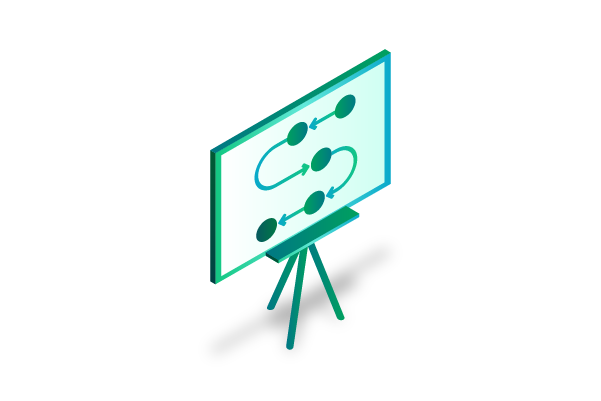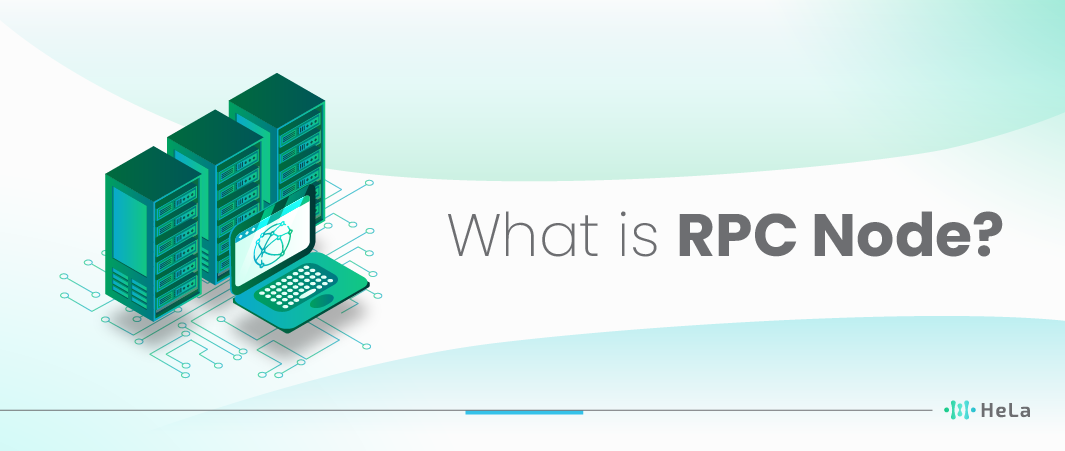In today’s digital age, the evolution of how we transact, communicate, and perceive value is ongoing. Blockchain technology, with its innovations like cryptocurrencies and smart contracts, stands out as a game-changer. Yet, amidst this transformation, many remain unaware of the unsung heroes known as RPC Nodes.
RPC Nodes, or Remote Procedure Call Nodes, play a pivotal role by acting as intermediaries, connecting our everyday applications to the blockchain. They serve as translators, making the complex blockchain language accessible to users and ensuring our actions, such as sending cryptocurrencies or executing smart contracts, seamlessly interact with the blockchain. These nodes silently facilitate connectivity, making blockchain technology user-friendly and accessible to all.
What Is RPC Node?
In the world of blockchain, think of an RPC Node as the friendly middleman that helps different computer programs talk to the blockchain. It’s like having a go-between that allows one computer to ask another computer to do something. You can picture it as a server that’s really good at receiving and handling requests through a special protocol called Remote Procedure Call (RPC). This protocol makes it possible for applications, such as wallet interfaces or DApps (Decentralized Applications), to interact with the blockchain.
So, when a wallet or DApp needs to do something on the blockchain, like sending a transaction or checking your balance, they send their requests to the RPC Node. The RPC Node understands these requests and communicates with the blockchain to make things happen. It’s kind of like sending a message to your friend, who then talks to someone else on your behalf, except here, it’s all about computers and the blockchain.
In simple terms, an RPC Node is like a helpful messenger that connects your favorite applications to the blockchain, ensuring that everything runs smoothly and securely. It plays a crucial role in making blockchain technology more accessible and user-friendly for everyone.
Operating an RPC node enables developers and users to:
- Send and receive transactions.
- Query block and transaction data.
- Engage with smart contracts.
In essence, without RPC nodes, our favorite cryptocurrency wallets, DeFi platforms, and other blockchain-based applications would be in the dark, unable to communicate with the blockchain.
Also Read: Components of a Blockchain Network: Exploring the Building Blocks
The Importance of RPC Nodes in Blockchain

RPC (Remote Procedure Call) nodes play a pivotal role in the daily operations of blockchain networks by facilitating various critical functions. These functions are essential for the seamless operation of blockchain ecosystems and include:
Data Retrieval
RPC nodes allow users and developers to access blockchain data, such as transaction histories, account balances, and smart contract information. This data accessibility is crucial for transparency, auditability, and building decentralized applications (dApps).
Smart Contract Interaction
Smart contracts are self-executing agreements with predefined rules. RPC nodes enable the execution of these contracts by allowing users to interact with them, triggering specific actions or transactions. This interaction is vital for a wide range of applications, from decentralized finance (DeFi) protocols to supply chain management.
Transaction Broadcasting
RPC nodes assist in broadcasting new transactions to the blockchain network. This function ensures that transactions are validated and added to the blockchain, contributing to the network’s consensus mechanism. It is fundamental to the secure and efficient transfer of digital assets and the overall network’s reliability.
Network Connectivity
RPC nodes serve as a bridge between end-users or applications and the blockchain network. They maintain the network’s connectivity, enabling the submission of requests and receiving responses, which helps in seamless data transfer and interaction with the blockchain.
Node Operations
RPC nodes also play a role in managing and configuring other network nodes. They assist in initiating and monitoring other nodes’ activities, which is important for maintaining a healthy and robust blockchain network.
Debugging and Development
Developers rely on RPC nodes for testing, debugging, and deploying smart contracts and applications. These nodes provide a means to interact with the blockchain in a controlled environment, aiding in the development and enhancement of blockchain-based projects.
Customization
RPC nodes can be customized to meet specific requirements, such as filtering data, monitoring specific addresses, or tailoring interactions with the blockchain. This flexibility is valuable for building custom applications and services that leverage blockchain technology.
RPC nodes are the backbone of many blockchain networks, providing the essential infrastructure for data access, smart contract execution, transaction processing, and network maintenance. Their importance extends to developers, businesses, and end-users, as they enable the full potential of blockchain technology and its applications to be realized.
How Does an RPC Node Work?

An RPC node, in the context of a blockchain network, acts as a crucial communication gateway between applications and the blockchain. To better understand how an RPC node works, let’s continue with the city analogy.
Imagine that each RPC node in the network is like a checkpoint within the city, strategically located to serve as a bridge between the bustling metropolis (the blockchain) and the external world (applications). Here’s a more detailed breakdown of how an RPC node functions:
Request Origination
Applications, like businesses or residents in the city, generate requests when they need specific information or want to perform transactions on the blockchain. These requests are akin to orders or inquiries about the city’s resources and services.
RPC Request Routing
Just as residents use the road network to reach their desired destinations within the city, applications send their RPC requests along the network of RPC nodes. The request finds its way to the nearest or most suitable RPC node based on factors like network configuration, proximity, and availability.
Request Handling
When the RPC node receives an incoming request, it acts as the city’s information center. It interprets the request, understanding what the application is asking for, and prepares to navigate the city (the blockchain) to retrieve or modify the required data.
Data Retrieval or Modification
The RPC node accesses the blockchain’s blocks and transactions, extracting or updating the necessary information. It may consult with other nodes or utilize its own resources to accomplish the task. This step is like the RPC node navigating the city streets and interacting with its fellow citizens (transactions and blocks) to gather the needed data.
Processing and Validation
The RPC node verifies the integrity and accuracy of the data it has obtained. It checks whether the requested transaction is valid and complies with the city’s rules (consensus algorithms and smart contracts). If all checks pass, the data is considered reliable and ready for transmission.
Response Creation
Just as the city’s residents or services provide answers or services to those who made requests, the RPC node assembles a response. This response includes the requested information from the blockchain, and it is prepared for delivery.
Response Delivery
Finally, the RPC node sends the response back to the requesting application via the same network of roads and highways. The application receives the data it needs, completing the communication loop. This is similar to residents receiving the products they ordered or the information they sought from the city.
In summary, RPC nodes are the critical intermediaries in a blockchain network, facilitating communication between external applications and the blockchain’s infrastructure. They play a key role in handling requests, accessing data, verifying transactions, and delivering responses, ensuring that the blockchain city’s resources are accessible and usable by its residents (applications).
Also Read: Crypto Market Sentiment: Impact on Cryptocurrency Valuations
Challenges and Solutions in RPC Node Management
Operating an RPC (Remote Procedure Call) node in a blockchain network comes with a set of challenges that can impact its functionality and security. Here are some key challenges and potential solutions in RPC node management:
Scalability Challenge
As the popularity of the blockchain network grows, an increasing number of applications and users can put a strain on RPC nodes, leading to performance issues and delays in processing requests.
Solution:
- Load balancing is a technique that involves distributing incoming requests across multiple RPC nodes. This helps prevent overloading on a single node and ensures that the network can handle a larger volume of requests. Load balancers can be configured to distribute traffic based on various algorithms, such as round-robin or least connections, to achieve efficient resource utilization.
Maintenance Challenge
RPC nodes require regular maintenance, updates, and monitoring to ensure they operate optimally. Neglecting maintenance can lead to vulnerabilities and degraded performance.
Solution:
- Up-to-date Software and Regular Maintenance: Keeping the RPC node software up to date is crucial for security and performance. Regularly applying software updates and patches helps address vulnerabilities and ensures that the node can take advantage of the latest features and improvements. Additionally, continuous monitoring and maintenance of the node’s hardware and software components are essential for its reliable operation.
Security Challenge
RPC nodes serve as access points to the blockchain network and are potential targets for malicious attacks. Security vulnerabilities in nodes can lead to unauthorized access or other security breaches.
Solution:
- Decentralization and Security Measures: Decentralization is a fundamental principle in blockchain networks. Encouraging more participants to run RPC nodes can enhance the network’s robustness and security. A decentralized network is less vulnerable to a single point of failure or attack. Additionally, implementing security measures like firewalls, access control policies, and intrusion detection systems can help protect RPC nodes from unauthorized access and malicious activities.
It’s important for blockchain projects and communities to address these challenges and implement these solutions to maintain a stable and secure RPC node infrastructure, ensuring the reliability and scalability of the network as it continues to grow and evolve.
The Future of RPC Nodes

As blockchain adoption continues to accelerate, the role of RPC (Remote Procedure Call) nodes is poised to become increasingly vital within the blockchain ecosystem. This upsurge in importance is not solely due to the growing adoption of blockchain technology, but it is also attributed to several other key factors that are shaping the future of RPC nodes. These factors include:
Increased Demand
With more organizations and developers embracing blockchain technology, there will be a surge in the demand for RPC nodes. These nodes act as intermediaries, facilitating communication between blockchain networks and decentralized applications. As the number of decentralized applications (DApps) and blockchain-based services proliferates, the need for reliable RPC nodes will be on the rise. Consequently, we can anticipate a proliferation in the quantity of RPC nodes, each striving to meet the growing demand while ensuring high levels of reliability and availability.
Technological Advancements
The evolving landscape of blockchain technology will drive innovations in RPC nodes. Developers will need to create nodes that are capable of handling the increased traffic generated by a multitude of DApps and users. This will lead to advancements in node technology, with a focus on optimizing performance, scalability, and response times. These technological enhancements will be crucial for ensuring that RPC nodes can keep pace with the rapidly expanding blockchain ecosystem.
Integration with Other Technologies
As blockchain matures, it is likely to converge with other emerging technologies, such as artificial intelligence (AI). The integration of RPC nodes with AI can have a transformative impact on the capabilities of blockchain networks. AI can be utilized to enhance the efficiency and security of blockchain transactions, making them more resilient to fraud and attacks. Additionally, AI can help in predictive maintenance of RPC nodes, identifying potential issues before they lead to network disruptions. These synergies between RPC nodes and AI will contribute to a more robust and adaptive blockchain infrastructure.
The future of RPC nodes is closely tied to the growth and development of blockchain technology. As blockchain adoption surges, the demand for reliable RPC nodes will increase significantly. This, in turn, will drive technological innovations to meet the rising demands, with a focus on optimizing performance and scalability. Furthermore, the integration of RPC nodes with emerging technologies like AI holds the potential to further enhance the capabilities and security of blockchain networks, ensuring they remain at the forefront of the digital revolution.
Conclusion
In the vast and intricate tapestry of blockchain technology, RPC nodes might not always be in the spotlight. Still, their silent, relentless work forms the bedrock of blockchain connectivity. They are the unsung heroes ensuring that our digital wallets show the correct balance, our DeFi trades executed smoothly, and our favorite DApps run seamlessly.
As we look forward to a world where blockchain plays an even more pivotal role in our daily lives, the importance of understanding and appreciating these nodes becomes paramount. After all, in the interconnected world of blockchain, every building block, including the humble RPC Node, plays a crucial role in creating the bigger picture.
Disclaimer: The information provided by HeLa Labs in this article is intended for general informational purposes and does not reflect the company’s opinion. It is not intended as investment advice or recommendations. Readers are strongly advised to conduct their own thorough research and consult with a qualified financial advisor before making any financial decisions.

I am Carina Caringal, a technical writer specializing in blockchain engineering concepts, decentralized systems, crypto infrastructure, and Web3 technologies. My work focuses on analyzing and translating complex technical mechanisms into precise, structured, and insightful content for both developers and non-technical readers who want a deeper understanding of the decentralized ecosystem.
My background in blockchain and cryptocurrency is rooted in years of independent research, continuous learning, and hands-on exploration across multiple protocols and network architectures. I study the underlying mechanics of distributed ledger technology, from consensus algorithms and smart contract logic to network scalability, security models, cryptographic principles, and interoperability frameworks. This technical foundation shapes the way I approach every article, ensuring accuracy, depth, and relevance.
- Carina Caringalhttps://helalabs.com/blog/author/carina-caringal/
- Carina Caringalhttps://helalabs.com/blog/author/carina-caringal/
- Carina Caringalhttps://helalabs.com/blog/author/carina-caringal/
- Carina Caringalhttps://helalabs.com/blog/author/carina-caringal/

